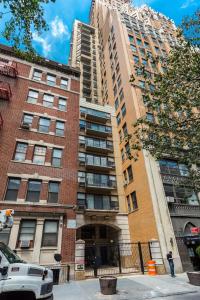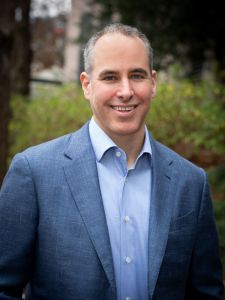Silverback Development Founder Josh Schuster Talks Financing and What Makes Him Tick
By Mack Burke November 21, 2017 3:17 pm
reprints
At the age of 33, Silverback Development founder Josh Schuster has already started and sold two real estate companies. He now sits at the helm of his own real estate platform, founded just a year ago.
An Ohio native, Schuster has real estate in his blood. His grandfather, Jack Schuster, who passed away in 2004, was well known in New York as a project executive and owner’s rep in the 1980s and 1990s. As a kid, Josh would visit him and tour construction sites. “Watching how he interacted with people, you could just feel the aura. There was a lot of respect,” Schuster told CO. “What I’ve found in this industry is that respect is something that is earned.”
Schuster, a graduate of Tulane University in New Orleans, became fascinated with real estate after enrolling in a few courses on the asset type while in undergraduate school. He went on to intern for a real estate developer and worked on the rebuild after hurricane Katrina. His first industry gig out of school was with Brooklyn-based JMH Development as a managing director, working on developing multifamily units for sale and rental properties, including 184 Kent Avenue in Williamsburg, a hotel in Miami, an 11-acre rental complex in College Point, Queens, and several land acquisitions across the West Coast.
After several years at JMH Development, Schuster struck out on his own and started Northpark Development, where he spearheaded projects such as a renovation to 14 apartments at 53 Pitt Street, a seven-story residential building in the Lower East Side—between Delancey and Rivington Streets—and a ground-up development site at 75 First Avenue that the firm later sold. He went on to launch a sister company called Northpark Property Management, which he eventually sold, Schuster said.
In October 2011, Schuster formed New York City-based real estate development and investment firm DHA Capital with the firm’s current Managing Principal Dan Hollander. Under that flag, the pair closed 10 transactions, half of which were sold and the other half developed. Schuster departed DHA Capital in July 2016.
At Silverback—started in July 2016—Josh is forging his own footprint while gladly carrying the family torch. He sat down with CO at his Midtown office at 40 West 57th Street to discuss his firm’s first year, its investment and development strategies and its goals for the future.
Why the name “Silverback”?
I often joke that it’s my animal spirit. Silverback gorillas are leaders; they’re proud animals. They take care of their families, and if you cross them the wrong way, they can climb to the top of the Empire State Building and pound their chests, right?
What spurred you into starting Silverback Development?
There was an opportunity to take a large investment from a high net worth family office and a large $13 billion institution. The opportunity was to back a new platform around a developer and to build a team around the developer and allow them to grow. I felt like it was the right time and the right place in my career to give that a shot. So far, it’s been quite a success.
What’s it been like in your first year operating the company?
There are different stages in the development cycle, so when you start a new company a lot of the attention is focused heavily on acquisitions. So, we’ve been in acquisitions mode. We have a three-pronged investment approach: One, we source our own deals; secondly, we team up with existing landowners that are usually second or third generation landowners who want to monetize an asset but may not have the experience or track record or capital to improve the asset and develop it to it’s highest and best uses. So, we come in and provide the balance sheet and the team and all that good stuff. Lastly, we’ll team up with guys who have already acquired sites from several years ago, and we’ll provide a silver lining and allow them to finance those sites.
What’s been keeping you busiest this year?
In addition to owning and building our own projects, we are doing some third-party development and asset management work. We’re doing some construction work. What’s keeping us most busy is continuing to identify opportunities that no one else can locate. We’re also starting a structured credit fund that’s taking up a lot of time, and that’s to focus on the gap in the capital stack and where lenders are today in rate and leverage and where equity wants to be in terms of total check size. So, there’s a huge gap that needs to be filled, and we’re originating some of those opportunities. We’re also talking to subordinate lenders that want to de-risk some of their positions and sell off the bottom piece of some of their existing debt, so it’s an opportunity to jump into a deal late in the loan term. That not only improves our yields, but we find ourselves in a position where our risk is somewhat mitigated. In addition to that, we’re developers at heart, so we know when a project is going sideways or behind schedule or over budget and et cetera. We can help the lender and ourselves—and the sponsor—get creative as to how we can improve the existing development.
Where do you typically find your debt and equity sources?
We have two professionals in house who focus on capital markets. We’re constantly fostering existing relationships, and we’re trying to find new relationships on the equity side. We have several family offices that are recurring investors; we have several family offices that want to continue to invest or establish a new relationships so they can continue to invest. On the debt side, there are only a handful of construction lenders out there in the marketplace today. We have some pretty strong relationships with banks already, and for those that we don’t, we work with talented advisory groups that get us in front of the right banks.
How have you found the appetite for new financing over the last year?
We’re seeing lenders pull back; they’re a little cautious. They see an oversupply of rental inventory and condos. As a result, I think they’re adjusting their risk profiles by reducing their leverage point. So, lenders who were lending at 65 or 70 percent are now 5 or 10 percent below those marks. And, that’s what inspired us to consider this structured credit fund because, as the banks are dropping their leverage and let’s say equity remains the same, you have a larger pocket of capital that needs to be filled.
Do you like to consider high-leverage debt opportunities, or do you tend to stay away from that?
It really depends on the circumstance. High-leverage can be a scary term when you think about getting 80 to 85 percent levered, but in the some of the instances where we can structure our deals through joint ventures and we can subordinate the land value, there’s some cushion relative to our equity position in the capital stack. So, on paper, it sides like high-leverage, but in practice it ends up being more palpable.
How’s your pipeline—you’ve said it’s valued at around $2 billion—looking for the rest of the year?
We’re very comfortable where we are with our pipeline. We have two projects in Florida, one project in Connecticut, one in Washington, D.C. We’re looking at a large project in Boston. Roughly 70 percent of the portfolio is in New York—it’s our backyard. We have projects in New Jersey. I’d like to find more joint venture opportunities—and those always take the longest time—so I think as we go into 2018, we’ll continue to nourish those relationships so by the beginning of next year we have more deals to announce.
You started your company at an interesting time—around the U.S. Election and the Brexit outcome—was that a hurdle or did you see it a potentially advantageous position?
You know, it’s interesting. Starting a company at any time is always a daunting challenge. We’ve always been contrarian investors and developers, so we don’t let tailwinds and headwinds steer our decision to make investments. We make prudent investments. The way we’ve been structuring our deals allows us to succeed in any market. I think we’re kind of a new ballgame. We shouldn’t be focusing on the end of the cycle and the end of the world. Everyone still remembers the Great Recession and thinks that is right around the corner again, but there’s a lot of capital available on the sidelines. There’s a lack of deal flow for that capital because of where land pricing currently is and because of the cost of capital and cost of construction, let’s say. So, there are several challenges to get through, but if you can solve that through structure, I think it’s relatively easy to get deals done. And we’re finding that, if you look at our robust pipeline and our ability to circle up a $2.5 billion pipeline and then building a team around that—across five states. It’s just about identifying the opportunity and creating value, if possible.
What have the circumstances meant for you and the firm in terms of capital?
We have new capital flowing in from Argentina. There’s capital coming from Japan—it’s finally coming on shore. We’re seeing a lot of family office money coming in from London and Eastern Europe. So, folks who want to invest in real estate in New York, they don’t really know where to start, or let’s say folks in Japan who want to grow a platform—kind of what Mitsui did—it’ll take them five to seven years to get to where we are today. And, because we already have the deal flow and the pipeline, it’s a lot easier for these folks to make a more programmatic investment.
How are your most recent projects progressing?
A lot of our pipeline is in predevelopment, so really, the grunt work and value creation is always in pre-construction. Arguably, construction is the easy part; you’re managing the CM and the schedule and the budget. But, getting the drawings and design right—we like to focus on architecturally distinct projects—it’s all about layouts, it’s all about price points, and it’s all about the amenity packages. How are we targeting the demographic? How are we luring traffic to the building, whether it’s a rental or condo? On the office market side, where do we want to construct office properties or reposition offices, who are we really tapping into and who’s leasing those spaces? Fundamentally, it’s about understanding and catering to the right audience.
Talk about your recent work. I understand you have plans in Brooklyn Heights and Gramercy Park?
We’re repositioning a 29-story building in Brooklyn Heights (67 Livingston Street). It’s unique because it has panoramic views of the city, the Statue of Liberty and the Verrazano Bridge. We’re delivering full-floor apartments—two, three and four bedrooms—where elevators open up into your space so you have a private mansion in the sky, if you will. We’re trying to keep the price points somewhere between $2 million and $4 million. I think that doesn’t exist in Brooklyn Heights. We also focus on micro markets, finding pockets within existing mature neighborhoods. Gramercy Park is a great example. There’s a lot of opportunity east of Third Avenue where there are sites you and acquire that have close proximity to the park and the Second Avenue subway line. We also some third party owner’s rep and development management work, so right now we’re repositioning an office building for a client, and we’re repositioning a hospital for a client. We have a 13 person team here, ranging from construction veterans down to analysts and everywhere in between. We really are a full-service shop and the goal is to eventually be vertically integrated in terms of having everything under one roof.

What are you trying to accomplish with your current building design strategy and how does that appeal?
I think we’re trying to find a happy medium between modern and timeless. You don’t want to design for something that is great today and a couple years from now it feels stale and dated. You’re not really offering units until several years out, so a part of this is being a visionary and saying, Where are aesthetics trends heading and why? Also, incorporating a lot of technology into your design because, at the end of the day, technology is growing exponentially and it’s important to get ahead of that curve.
Do you remember your first transaction at Silverback?
Our first transaction was an acquisition of three office buildings in Stamford, Connecticut. What was unique about the opportunity was that it’s one of the last remaining central business development sites. It’s three acres; it’s got three office buildings that were 90 percent occupied, so there was some value creation in renting the balance of the space. And, it was cash flow positive and created a nice coupon for our investors. We’re continuing to operate those buildings. We like Stamford; we’re long on Stamford. We think that even though there’s a lot of negative press about the exodus of the Class A office market, folks that own those properties or banks that now own them, aren’t going to allow them to sit vacant forever.
You recently told CO your bread-and-butter asset class is residential. With that first acquisition, it seems you had always planned to venture into other areas.
We wanted to be asset class agnostic and just focus on where value creation could be ascertained. If someone would’ve told me that my first purchase would have been three office buildings in Stamford, Connecticut, I would’ve laughed at you. I was very surprised because the last 14 transactions I had prior to Silverback were residential.
You’ve also said you like to tour your construction sites?
Oh, I love that. One of my first transactions—53 Pitt Street—we essentially self-performed that project, so I was there daily. I’m one of the few developers out there that really understands the nitty gritty of construction and understands what happens behind the walls. [I learned that from] being in the field and watching the disciplines working in coordination with one another in practice and how it’s sequential. I think it’s important.
How did your grandfather, with his real estate background, influence you, specifically?
Well, I used to go with him to work, and that was an opportunity for him to show me blueprints—back when they were actually blue. He taught me how to use a ruler and a scale, and watching how he interacted with people, you could just feel the aura. There was a lot of respect. What I’ve found in this industry is that respect is something that is earned. Just because you’re an owner or developer doesn’t mean you’re going to get respect. People are going to respect you because they think you’re knowledgeable, your creating value, and they want to listen to the input you’re providing. That was something that resonated with me. There’s an expression, “You die twice: Once when they actually put you in the grave, and the second time when people stop saying your name.” Even to this day—and it’s been 11 or 12 years or so since he passed—I’ll be on calls with folks, and they’ll ask me if I’m related to Jack Schuster. They’ll say, “I remember Jack for this,” or “Jack taught me this.” It always puts a smile on my face because, one day when I die, I hope people are still talking about me.
Do you see it as he’s passed the baton, and you’re furthering a legacy, continuing to elevate the family’s name?
It gives me a lot of pride, and it certainly gives my family a lot of pride, that I’m sort of carrying the torch. Although it may have stopped for one of the generations [Schuster’s father is a physician], it’s passed on to me. I feel more of an obligation, I think, to be successful as a result to ensure that the Schuster name continues to grow. I didn’t have any direct assistance from [my grandfather] because he wasn’t in the business when I arrived, and so I sort of had to start from scratch and learn as an assistant project manager, starting my first business with a loan that I repaid upon maturity date, with interest—that gave me some pride too. This wasn’t a business that was handed to me; this was created from scratch. To me, in addition to making my family members and those carrying the name proud, it’s more about the fact that my [wife and I] started with two nickels to rub together, in a studio off Bleecker Street. Now, we’re pretty happy, and I like to think the business will continue to grow and be a success.


